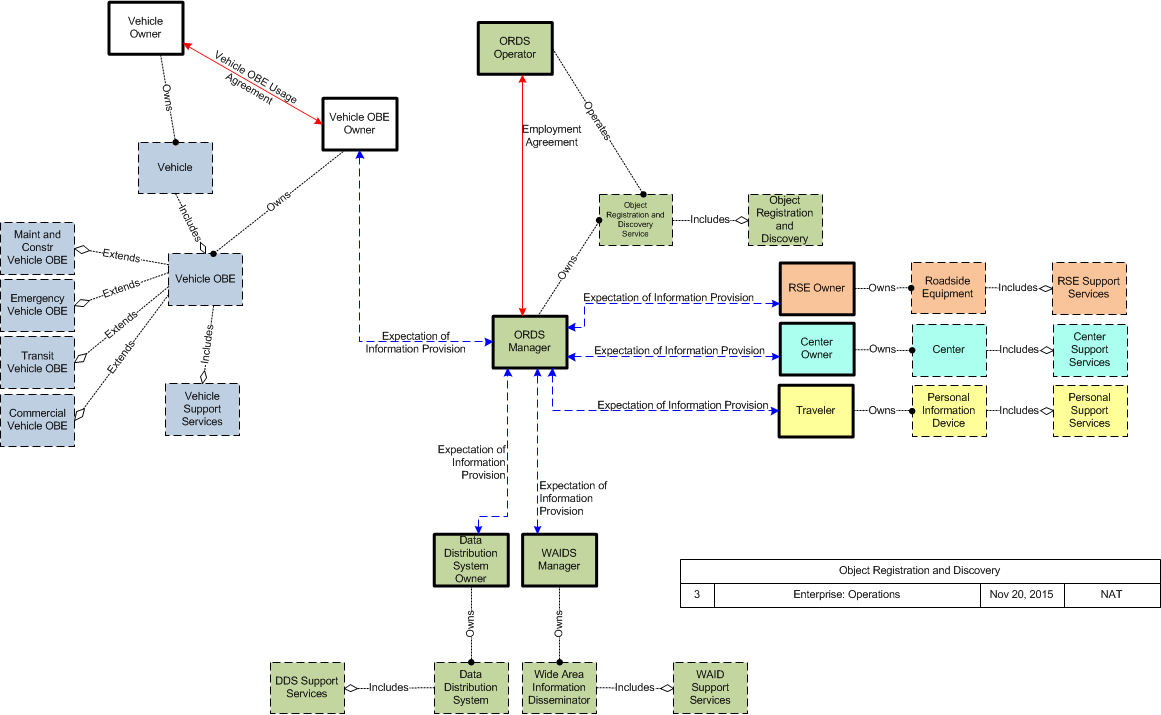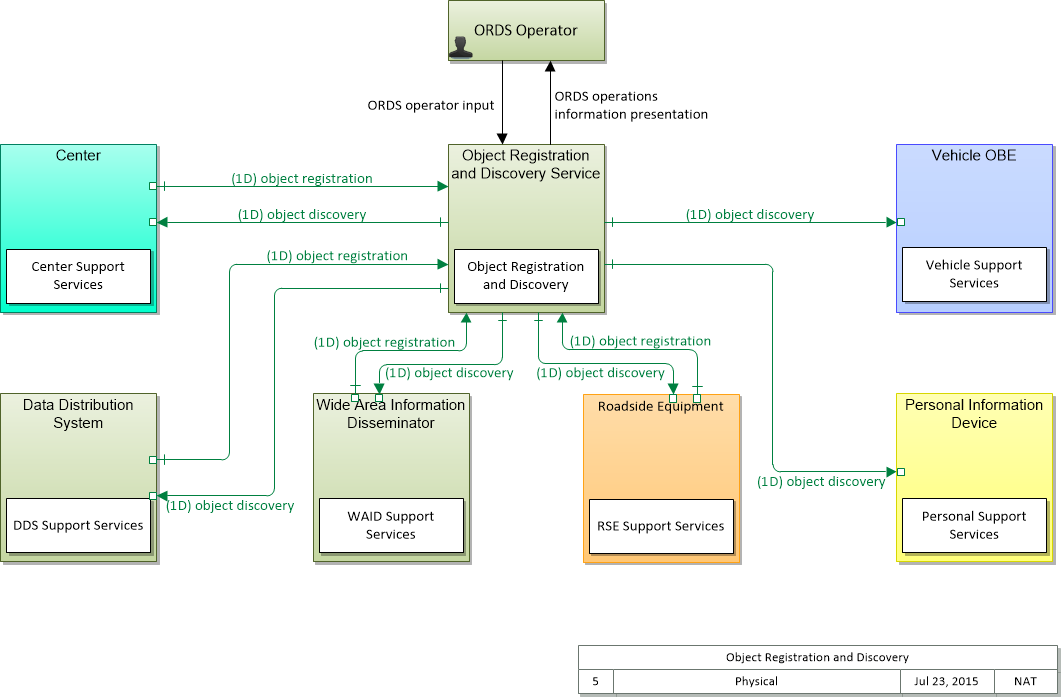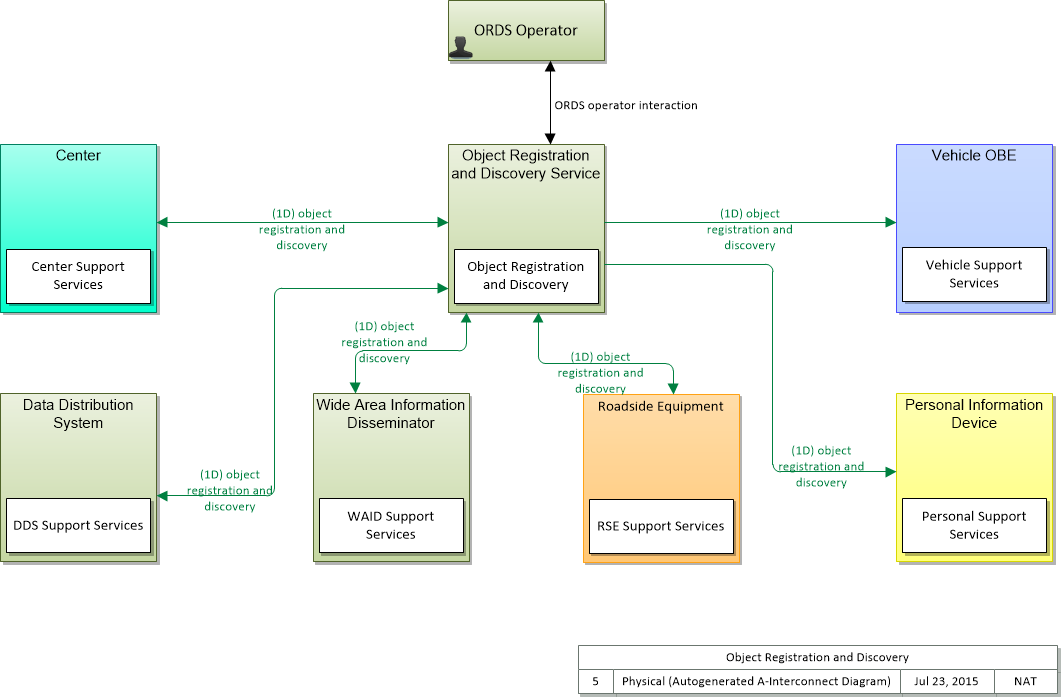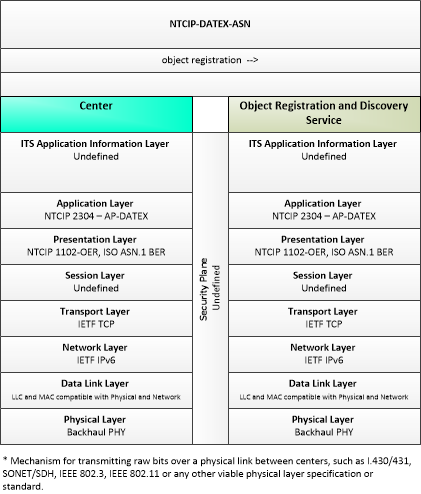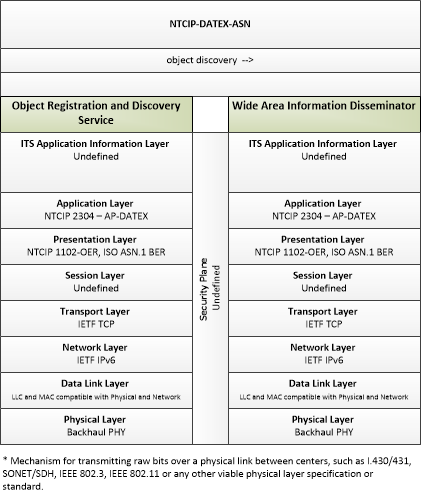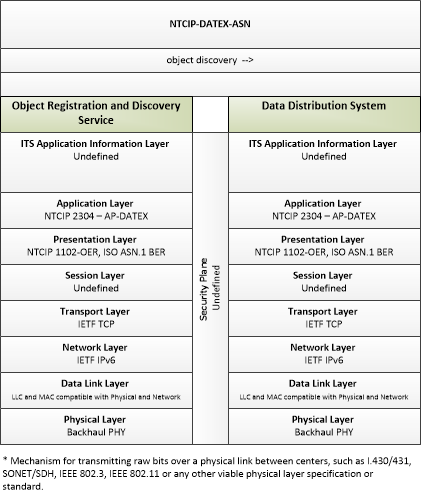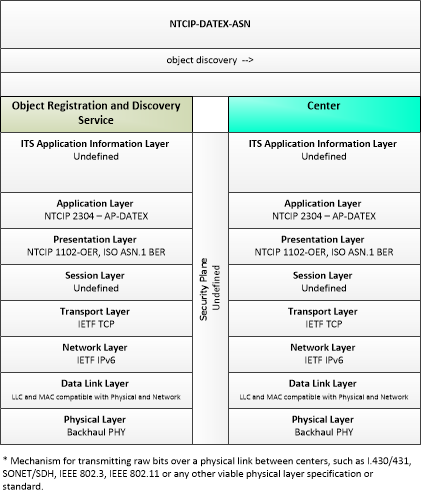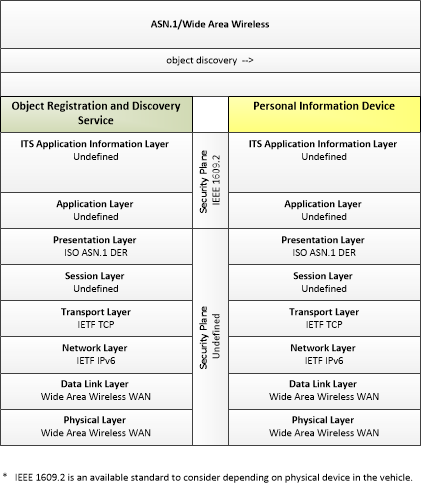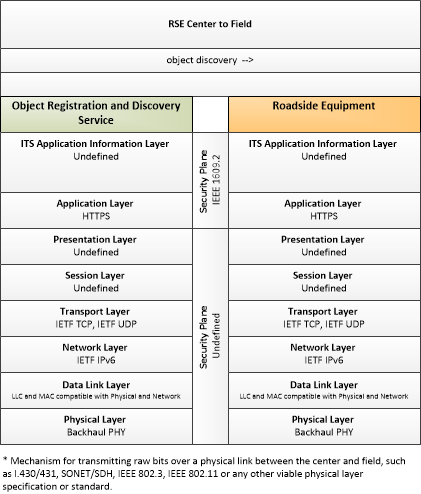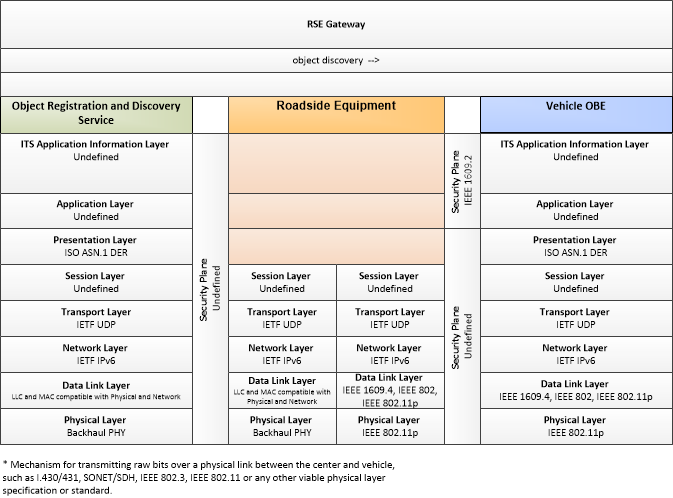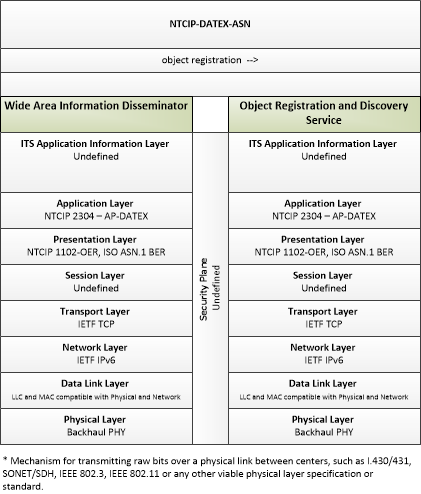Type: Support
Groups:- Core Services
Object Registration and Discovery
The Object Registration and Discovery application provides registration and lookup services necessary to allow objects to locate other objects operating within the Connected Vehicle Environment. This is a support application that enables other connected vehicle applications.
Enterprise
This is one way this application may be realized, but not the only way. There are other ways to build a given application and accomplish a stated objective.
The enterprise diagram can be viewed in SVG or PNG format and the current format is SVG. SVG Diagram
PNG Diagram

Business Interaction Matrix:
| Object Registration and Discovery Operations Stage | |||||||||
|---|---|---|---|---|---|---|---|---|---|
| Vehicle Owner | Vehicle OBE Owner | RSE Owner | Traveler | Center Owner | Data Distribution System Owner | ORDS Operator | ORDS Manager | WAIDS Manager | |
| Vehicle Owner | Vehicle OBE Usage Agreement | ||||||||
| Vehicle OBE Owner | Vehicle OBE Usage Agreement | Expectation of Information Provision | |||||||
| RSE Owner | Expectation of Information Provision | ||||||||
| Traveler | Expectation of Information Provision | ||||||||
| Center Owner | Expectation of Information Provision | ||||||||
| Data Distribution System Owner | Expectation of Information Provision | ||||||||
| ORDS Operator | Employment Agreement | ||||||||
| ORDS Manager | Expectation of Information Provision | Expectation of Information Provision | Expectation of Information Provision | Expectation of Information Provision | Expectation of Information Provision | Employment Agreement | Expectation of Information Provision | ||
| WAIDS Manager | Expectation of Information Provision | ||||||||
Includes Enterprise Objects:
| Enterprise Object | Description |
|---|---|
| Center Owner | General representation of the owner of the general "Center" physical object. |
| Data Distribution System Owner | The enterprise charged with providing data distribution services in the connected vehicle environment. This enterprise serves as broker between information and data providers and consumers. |
| ORDS Manager | The "ORDS Manager" represents the entity responsible for operating and maintaining the Object Registration and Discovery Service, charged with monitoring its operational status and responding to operational issues related to it. |
| ORDS Operator | The 'Object Registration and Discovery Service Operator' represents the person or people that monitor and manage the Object Registration and Discovery Service. |
| RSE Owner | The owner of roadside equipment. |
| Traveler | The 'Traveler' represents any individual who uses transportation services. The interfaces to the traveler provide general pre-trip and en-route information supporting trip planning, personal guidance, and requests for assistance in an emergency that are relevant to all transportation system users. It also represents users of a public transportation system and addresses interfaces these users have within a transit vehicle or at transit facilities such as roadside stops and transit centers. |
| Vehicle OBE Owner | The entity, individual, group or corporation that owns the Vehicle On-Board equipment. This could be the same as the Vehicle Owner, but it could be a third part that licenses the use of the OBE to the Owner. |
| Vehicle Owner | The individual, group of individuals or corporate entity that is identified as the registered owner of the Vehicle under state law. |
| WAIDS Manager | The "WAIDS Manager" represents the entity responsible for operating and maintaining the Wide Area Information Disseminator, charged with monitoring its operational status and responding to operational issues related to it. |
Includes Resources:
| Resource | Description |
|---|---|
| Center | This general physical object is used to model core capabilities that are common to any center. |
| Center Support Services | 'Center Support Services' provides foundational functions that support data collection, management, and distribution. It coordinates with Object Registration and Discovery to maintain its registration with respect to location/geographic scope and credentialing information. It maintains the necessary security credentials, authorizations, and associated keys to support communications in the connected vehicle environment. |
| Commercial Vehicle OBE | The Commercial Vehicle On-Board Equipment (OBE) resides in a commercial vehicle and provides the sensory, processing, storage, and communications functions necessary to support safe and efficient commercial vehicle operations. It provides two-way communications between the commercial vehicle drivers, their fleet managers, attached freight equipment, and roadside officials. In CVRIA, a separate 'Vehicle OBE' physical object supports the general V2V and V2I safety applications and other applications that apply to all vehicles, including commercial vehicles. The Commercial Vehicle OBE supplements these general capabilities with capabilities that are specific to commercial vehicles. |
| Data Distribution System | The 'Data Distribution System' collects, processes, and distributes connected vehicle data, connecting data producers with data consumers and facilitating data exchange in the Connected Vehicle Environment. |
| DDS Support Services | "DDS Support Services" provides foundational functions that support data collection, management, and distribution. It coordinates with Object Registration and Discovery to maintain its registration with respect to location/geographic scope and credentialing information. It maintains the necessary security credentials, authorizations, and associated keys to support communications in the connected vehicle environment. It also provides an overall service monitoring function. |
| Emergency Vehicle OBE | The Emergency Vehicle On-Board Equipment (OBE) resides in an emergency vehicle and provides the processing, storage, and communications functions that support public safety-related connected vehicle applications. It represents a range of vehicles including those operated by police, fire, and emergency medical services. In addition, it represents other incident response vehicles including towing and recovery vehicles and freeway service patrols. It includes two-way communications to support coordinated response to emergencies. In CVRIA, a separate 'Vehicle OBE' physical object supports the general V2V and V2I safety applications and other applications that apply to all vehicles, including emergency vehicles. The Emergency Vehicle OBE supplements these general capabilities with capabilities that are specific to emergency vehicles. |
| Maint and Constr Vehicle OBE | The 'Maint and Constr Vehicle OBE' resides in a maintenance, construction, or other specialized service vehicle or equipment and provides the processing, storage, and communications functions necessary to support highway maintenance and construction. All types of maintenance and construction vehicles are covered, including heavy equipment and supervisory vehicles. The MCV OBE provides two-way communications between drivers/operators and dispatchers and maintains and communicates current location and status information. A wide range of operational status is monitored, measured, and made available, depending on the specific type of vehicle or equipment. A snow plow for example, would monitor whether the plow is up or down and material usage information. The Maint and Constr Vehicle OBE may also contain capabilities to monitor vehicle systems to support maintenance of the vehicle itself and include sensors that monitor environmental conditions such as road condition and surface weather information. This can include a diverse set of mobile environmental sensing platforms, including wheeled vehicles and any other vehicle that collects and reports environmental information. In CVRIA, a separate 'Vehicle OBE' physical object supports the general V2V and V2I safety applications and other applications that apply to all vehicles, including maintenance and construction vehicles. The Maint and Constr Vehicle OBE supplements these general applications with applications that are specific to maintenance and construction vehicles. |
| Object Registration and Discovery | 'Object Registration and Discovery' facilitates the registration of services by the respective service providers and the subsequent query-based discovery of these registered services. Many of the services offered by roadside or center-based service providers operating within the project geographic boundary will require an advertisement of their existence and cyber location to potential users; which consist primarily of PIDs and vehicles, but could include roadside or other center based services. |
| Object Registration and Discovery Service | The 'Object Registration and Discovery Service' represents one or more center-based applications that provide registration and lookup services necessary to allow objects to locate (for communications purposes) other objects operating within the Connected Vehicle Environment. These registration and discovery services are support services that enable other applications. |
| Personal Information Device | The 'Personal Information Device' provides the capability for travelers to receive formatted traveler information wherever they are. Capabilities include traveler information, trip planning, and route guidance. Frequently a smart phone, the Personal Information Device provides travelers with the capability to receive route planning and other personally focused transportation services from the infrastructure in the field, at home, at work, or while en-route. Personal Information Devices may operate independently or may be linked with connected vehicle on-board equipment. |
| Personal Support Services | 'Personal Support Services' provides foundational functions that supports data collection, management, and distribution. It coordinates with Object Registration and Discovery to maintain its registration with respect to location/geographic scope and credentialing information. It maintains the necessary security credentials, authorizations, and associated keys to support communications in the connected vehicle environment. |
| Roadside Equipment | 'Roadside Equipment' (RSE) represents the Connected Vehicle roadside devices that are used to send messages to, and receive messages from, nearby vehicles using Dedicated Short Range Communications (DSRC) or other alternative wireless communications technologies. Communications with adjacent field equipment and back office centers that monitor and control the RSE are also supported. This device operates from a fixed position and may be permanently deployed or a portable device that is located temporarily in the vicinity of a traffic incident, road construction, or a special event. It includes a processor, data storage, and communications capabilities that support secure communications with passing vehicles, other field equipment, and centers. |
| RSE Support Services | 'RSE Support Services' provides foundational functions that supports data collection, management, and distribution. It coordinates with Object Registration and Discovery to maintain its registration with respect to location/geographic scope and credentialing information. It maintains the necessary security credentials, authorizations, and associated keys to support communications in the connected vehicle environment. |
| Transit Vehicle OBE | The Transit Vehicle On-Board equipment (OBE) resides in a transit vehicle and provides the sensory, processing, storage, and communications functions necessary to support safe and efficient movement of passengers. The types of transit vehicles containing this physical object include buses, paratransit vehicles, light rail vehicles, other vehicles designed to carry passengers, and supervisory vehicles. It collects ridership levels and supports electronic fare collection. It supports a traffic signal prioritization function that communicates with the roadside physical object to improve on-schedule performance. Automated vehicle location enhances the information available to the transit operator enabling more efficient operations. On-board sensors support transit vehicle maintenance. The physical object supports on-board security and safety monitoring. This monitoring includes transit user or vehicle operator activated alarms (silent or audible), as well as surveillance and sensor equipment. The surveillance equipment includes video (e.g. CCTV cameras), audio systems and/or event recorder systems. It also furnishes travelers with real-time travel information, continuously updated schedules, transfer options, routes, and fares. In CVRIA, a separate 'Vehicle OBE' physical object supports the general V2V and V2I safety applications and other applications that apply to all vehicles, including transit vehicles. The Transit Vehicle OBE supplements these general capabilities with capabilities that are specific to transit vehicles. |
| Vehicle | The conveyance that provides the sensory, processing, storage, and communications functions necessary to support efficient, safe, and convenient travel. These functions reside in general vehicles including personal automobiles, commercial vehicles, emergency vehicles, transit vehicles, or other vehicle types. |
| Vehicle OBE | The Vehicle On-Board Equipment (OBE) provides the vehicle-based processing, storage, and communications functions necessary to support connected vehicle operations. The radio(s) supporting V2V and V2I communications are a key component of the Vehicle OBE. This communication platform is augmented with processing and data storage capability that supports the connected vehicle applications. In CVRIA, the Vehicle OBE includes the functions and interfaces that support connected vehicle applications for passenger cars, trucks, and motorcycles. Many of these applications (e.g., V2V Safety applications) apply to all vehicle types including personal vehicles, commercial vehicles, emergency vehicles, transit vehicles, and maintenance vehicles. From this perspective, the Vehicle OBE includes the common interfaces and functions that apply to all motorized vehicles. |
| Vehicle Support Services | 'Vehicle Support Services' provides foundational functions that supports data collection, management, and distribution. It coordinates with Object Registration and Discovery to acquire necessary communications information. It maintains the necessary security credentials, authorizations, and associated keys to support communications in the connected vehicle environment. |
| WAID Support Services | "WAID Support Services" provides foundational functions that support data collection, management, and distribution. It coordinates with Object Registration and Discovery to maintain its registration with respect to location/geographic scope and credentialing information. It maintains the necessary security credentials, authorizations, and associated keys to support communications in the connected vehicle environment. It also provides an overall service monitoring function. |
| Wide Area Information Disseminator | The 'Wide Area Information Disseminator' represents the Connected Vehicle center based systems and communications equipment that is used to send messages to equipped vehicles using wide-area wireless communications such as satellite radio, terrestrial FM broadcast subcarrier, or cellular data networks. |
Includes Roles:
| Role | Description |
|---|---|
| Operates | An Enterprise controls the functionality and state of the target Resource. An Enterprise that Operates a resource is considered Responsible. |
| Owns | An Enterprise has financial ownership and control over the Resource. An Enterprise that Owns a resource is considered Accountable. |
Includes Coordination:
| Coordination | Type | Description |
|---|---|---|
| Employment Agreement | Agreement | An agreement between an individual and a corporation or government entity, whereupon the individual agrees to provide labor to the corporation/agency, which in turn compensates the employee. Stipulates level of compensation, working conditions, necessary equipment and training and expectations of employee performance. |
| Expectation of Information Provision | Expectation | An expectation where one party believes another party will provide it information whenever such information is likely relevant to the recipient. |
| Extends | Includes | Indicates that one component includes all of the functionality of another component, and in provides additional functionality beyond that other component's. |
| Includes | Includes | Indicates that one component is entirely contained within another component. |
| Vehicle OBE Usage Agreement | Agreement | An agreement that grants one entity permission to use a Vehicle OBE that the other party controls. |
Functional
Includes Processes:
| Level | Name | Type | Allocated to Application Object |
|---|---|---|---|
| 6 | Provide Driver and Traveler Services | Collection | |
| 6.11.2 | Manage Dissemination of Traveler Information | Pspec | |
| 10.1.5.1 | Support Connected Vehicle Center Communications | Pspec | |
| 10.1.5.2 | Support Connected Vehicle Field Communications | Pspec |
- RSE Support Services |
| 10.1.5.3 | Support Connected Vehicle Vehicle Communications | Pspec |
- Vehicle Support Services |
| 10.1.5.4 | Support Connected Vehicle Mobile Communications | Pspec |
- Personal Support Services |
| 10.4.9 | Support Object Registration and Discovery | Pspec |
- Object Registration and Discovery |
| 10.6.4 | Support Data Distribution Services | Pspec |
- DDS Support Services |
Includes Data Flows:
Physical
This is one way this application may be realized, but not the only way. There are other ways to build a given application and accomplish a stated objective.
The physical diagram can be viewed in SVG or PNG format and the current format is SVG. SVG Diagram
PNG Diagram

Includes Physical Objects:
| Physical Object | Class | Description |
|---|---|---|
| Center | Center | This general physical object is used to model core capabilities that are common to any center. |
| Data Distribution System | Support | The 'Data Distribution System' collects, processes, and distributes connected vehicle data, connecting data producers with data consumers and facilitating data exchange in the Connected Vehicle Environment. |
| Object Registration and Discovery Service | Support | The 'Object Registration and Discovery Service' represents one or more center-based applications that provide registration and lookup services necessary to allow objects to locate (for communications purposes) other objects operating within the Connected Vehicle Environment. These registration and discovery services are support services that enable other applications. |
| ORDS Operator | Support | The 'Object Registration and Discovery Service Operator' represents the person or people that monitor and manage the Object Registration and Discovery Service. |
| Personal Information Device | Traveler | The 'Personal Information Device' provides the capability for travelers to receive formatted traveler information wherever they are. Capabilities include traveler information, trip planning, and route guidance. Frequently a smart phone, the Personal Information Device provides travelers with the capability to receive route planning and other personally focused transportation services from the infrastructure in the field, at home, at work, or while en-route. Personal Information Devices may operate independently or may be linked with connected vehicle on-board equipment. |
| Roadside Equipment | Field | 'Roadside Equipment' (RSE) represents the Connected Vehicle roadside devices that are used to send messages to, and receive messages from, nearby vehicles using Dedicated Short Range Communications (DSRC) or other alternative wireless communications technologies. Communications with adjacent field equipment and back office centers that monitor and control the RSE are also supported. This device operates from a fixed position and may be permanently deployed or a portable device that is located temporarily in the vicinity of a traffic incident, road construction, or a special event. It includes a processor, data storage, and communications capabilities that support secure communications with passing vehicles, other field equipment, and centers. |
| Vehicle OBE | Vehicle | The Vehicle On-Board Equipment (OBE) provides the vehicle-based processing, storage, and communications functions necessary to support connected vehicle operations. The radio(s) supporting V2V and V2I communications are a key component of the Vehicle OBE. This communication platform is augmented with processing and data storage capability that supports the connected vehicle applications. In CVRIA, the Vehicle OBE includes the functions and interfaces that support connected vehicle applications for passenger cars, trucks, and motorcycles. Many of these applications (e.g., V2V Safety applications) apply to all vehicle types including personal vehicles, commercial vehicles, emergency vehicles, transit vehicles, and maintenance vehicles. From this perspective, the Vehicle OBE includes the common interfaces and functions that apply to all motorized vehicles. |
| Wide Area Information Disseminator | Support | The 'Wide Area Information Disseminator' represents the Connected Vehicle center based systems and communications equipment that is used to send messages to equipped vehicles using wide-area wireless communications such as satellite radio, terrestrial FM broadcast subcarrier, or cellular data networks. |
Includes Application Objects:
| Application Object | Description | Physical Object |
|---|---|---|
| Center Support Services | 'Center Support Services' provides foundational functions that support data collection, management, and distribution. It coordinates with Object Registration and Discovery to maintain its registration with respect to location/geographic scope and credentialing information. It maintains the necessary security credentials, authorizations, and associated keys to support communications in the connected vehicle environment. | Center |
| DDS Support Services | "DDS Support Services" provides foundational functions that support data collection, management, and distribution. It coordinates with Object Registration and Discovery to maintain its registration with respect to location/geographic scope and credentialing information. It maintains the necessary security credentials, authorizations, and associated keys to support communications in the connected vehicle environment. It also provides an overall service monitoring function. | Data Distribution System |
| Object Registration and Discovery | 'Object Registration and Discovery' facilitates the registration of services by the respective service providers and the subsequent query-based discovery of these registered services. Many of the services offered by roadside or center-based service providers operating within the project geographic boundary will require an advertisement of their existence and cyber location to potential users; which consist primarily of PIDs and vehicles, but could include roadside or other center based services. | Object Registration and Discovery Service |
| Personal Support Services | 'Personal Support Services' provides foundational functions that supports data collection, management, and distribution. It coordinates with Object Registration and Discovery to maintain its registration with respect to location/geographic scope and credentialing information. It maintains the necessary security credentials, authorizations, and associated keys to support communications in the connected vehicle environment. | Personal Information Device |
| RSE Support Services | 'RSE Support Services' provides foundational functions that supports data collection, management, and distribution. It coordinates with Object Registration and Discovery to maintain its registration with respect to location/geographic scope and credentialing information. It maintains the necessary security credentials, authorizations, and associated keys to support communications in the connected vehicle environment. | Roadside Equipment |
| Vehicle Support Services | 'Vehicle Support Services' provides foundational functions that supports data collection, management, and distribution. It coordinates with Object Registration and Discovery to acquire necessary communications information. It maintains the necessary security credentials, authorizations, and associated keys to support communications in the connected vehicle environment. | Vehicle OBE |
| WAID Support Services | "WAID Support Services" provides foundational functions that support data collection, management, and distribution. It coordinates with Object Registration and Discovery to maintain its registration with respect to location/geographic scope and credentialing information. It maintains the necessary security credentials, authorizations, and associated keys to support communications in the connected vehicle environment. It also provides an overall service monitoring function. | Wide Area Information Disseminator |
Includes Information Flows:
| Information Flow | Description |
|---|---|
| object discovery | Represents the interactive discovery of network communications related information by any end entity, querying the ORDS. Information exchange could be as simple as a Domain Name Service (DNS) query, or it could include service and service metric information. |
| object registration | Represents the provision of information related to communications, service and service metric information from a service provider end entity to the ORDS. |
| ORDS operations information presentation | Presentation of information to the ORDS Operator including current operational status of the Object Registration and Discovery Service. |
| ORDS operator input | User input from the ORDS operator including requests to monitor current system operation and inputs to affect system operation. |
Application Interconnect Diagram
This is one way this application may be realized, but not the only way. There are other ways to build a given application and accomplish a stated objective.
The application interconnect diagram can be viewed in SVG or PNG format and the current format is SVG. SVG Diagram
PNG Diagram
Application Triples
Requirements
| Need | Requirement | ||
|---|---|---|---|
| N4.001 | Applications need to protect data they handle from unauthorized access. This is required to support applications that exchange sensitive information, such as personally identifying or financial information, which if intercepted could compromise the privacy or financial records of the user. | 4.001 | Applications that function by exchanging data between entities shall be able to exchange encrypted data between those entities. |
| N4.002 | Applications need to establish trust between entities that operate components of the application. Such trust relationships are necessary so that applications can be assured that entities are who they say they are, and therefore trust the source and data it receives. | 4.002 | Applications shall verify that, for each entity on which an application component is installed, that entity is trusted by the provider of the application. |
| 4.003 | Applications shall be able to digitally sign all messages sent between entities. | ||
| 4.004 | Applications shall be able to verify the digital signature of received messages. | ||
| 4.005 | Digital signatures used to ensure trust shall be generated independently of the application sending the message to be signed. | ||
| N4.003 | Applications need to revoke the trust relationship they have between entities when necessary. A trusted entity may operate in a fashion that indicates it should no longer be trusted, in which case applications must have a way of revoking that trust. | 4.006 | Applications shall identify entities that provide messages to the application that are improperly formatted. |
| 4.007 | Applications shall identify entities that provide messages to the application that are logically inconsistent. | ||
| 4.008 | Applications shall revoke personal trust (trust by the application) when a repeated pattern of messages from a given entity falls outside of the applications tolerances. | ||
| 4.009 | Applications shall be able to report suspicious behavior to third party authentication providers. | ||
| 4.010 | Applications shall be able to accept messages from the third party authentication provider that identifies entities unworthy of trust. | ||
| 4.011 | Applications shall be able to revoke trust between itself and an entity if that entity is identified by the third party authentication provider as untrustworthy. | ||
| N4.004 | All participants in the Connected Vehicle Environment need to operate on a common time base. Coordination of time between the entities that operate applications as well as those providing Core services prevents internal errors and enables time-sensitive interactions between application components. | 4.012 | All applications shall use the same time source as the basis for timing. |
| N4.051 | Object Registration and Discovery (ORDS) needs to provide a secure repository for the collection, storage and dissemination of the cyber addresses and services of System Elements. This is essentially a list of "what" services are supported, "who" provides each service and "where" to go to obtain these services. | 4.129 | Object Registration and Discovery (ORDS) shall provide a secure repository for the collection, storage and dissemination of the cyber addresses and services. |
| N4.052 | ORDS needs to provide a mechanism for System Elements to store their current cyber addresses and services into a secure repository. | 4.130 | ORDS shall allow connected vehicle objects to register cyber addresses and services to an object repository. |
| N4.052a | ORDS needs to provide a mechanism to publish cyber addresses and services | 4.131 | ORDS shall be able to publish cyber addresses and services to connected vehicle objects. |
| N4.053 | ORDS needs to provide the trusted cyber addresses of System Elements located in a secure repository to other authorized System Elements. | 4.132 | ORDS shall provide cyber addresses of System Elements by network identifier. |
| 4.133 | ORDS shall provide cyber addresses of System Elements by application attribute. | ||
Related Sources
- Southeast Michigan Test Bed 2014 Concept of Operation, Draft, 12/29/2014
Security
In order to participate in this application, each physical object should meet or exceed the following security levels.
| Physical Object Security | ||||
|---|---|---|---|---|
| Physical Object | Confidentiality | Integrity | Availability | Security Class |
| Security levels have not been defined yet. | ||||
In order to participate in this application, each information flow triple should meet or exceed the following security levels.
| Information Flow Security | |||||
|---|---|---|---|---|---|
| Source | Destination | Information Flow | Confidentiality | Integrity | Availability |
| Basis | Basis | Basis | |||
| Security levels have not been defined yet. | |||||
